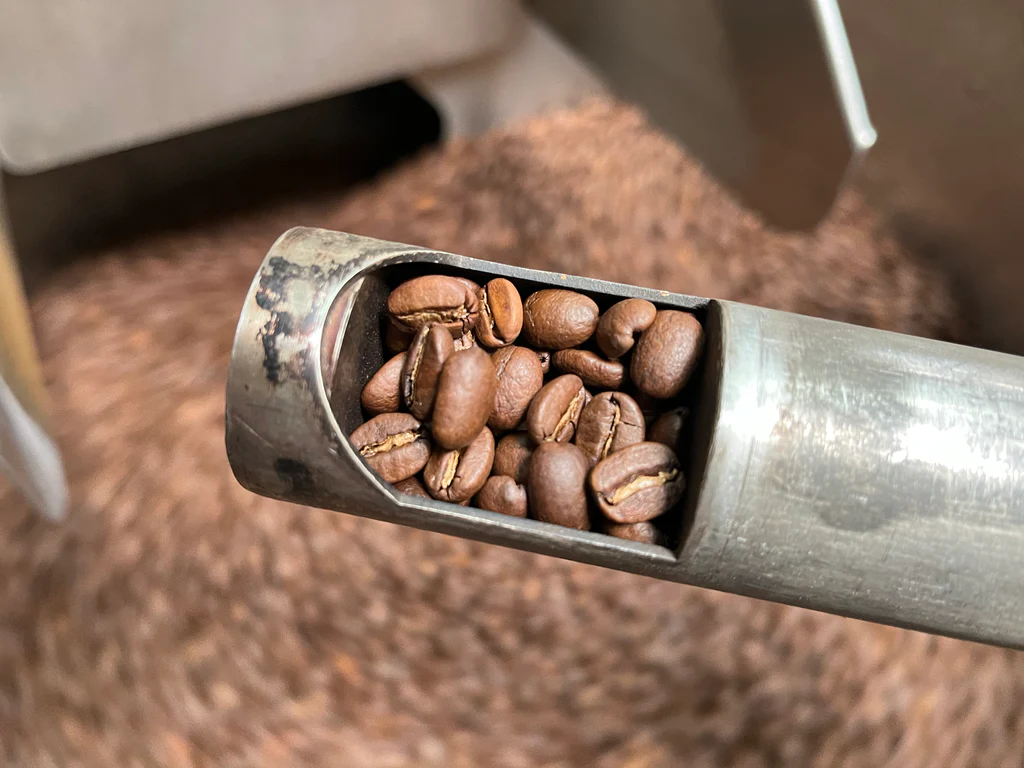
Inside The Coffee Roasting Process: Science, Art, Magic?

Coffee, the most popular drug in the world, the elixir that fuels our mornings and ignites our creativity, owes its diverse flavors and aromatic notes to a combination of plant genetics, geography and climate, processing, and finally, to roasting.
A coffee roaster can’t make a bad coffee taste good by roasting it well, but we do have enormous potential to ruin all the hard work producers have already put in. To that end, at Red Rock Roasters we do our best to understand the science of coffee roasting, to replicate good profiles consistently, and to use a little bit of artistic good taste in deciding how we’re going to turn the coffee brown.
Join us for a primer on roasting process and style, and discover how coffee goes from grassy green bean to aromatic caramelized roast.
What is coffee roasting?
When we receive raw coffee beans, they have been pulped, cleaned, dried, and sorted. The process looks different for each origin, but the end result for us is a hard little bean that, if ground and brewed, would taste a lot like uncooked split pea soup.
Roasting is about applying heat, at the right times and in the right amounts, so that those vegetal-tasting compounds transform into nutty, fruity, chocolaty, caramelly, sweet flavors. The tradeoff is that green-tasting chlorogenic acids turn into bitter, astringent quinic acids during the roast process, so our job is also to minimize the natural bitterness of coffee by a) maximizing sweetness through careful heat application, and b) not burning it.
Coffee roasting is a little like baking bread, and a little like making popcorn.
Here is our visual coffee roasting scale, labeled with the terminology we commonly use to describe how hot a coffee got before we decided it was done:
What’s the best coffee roasting style?
The heart of our approach at Red Rock Roasters is the fundamental principle that there's no single right or wrong way to roast coffee beans. Light roasts aren’t better than dark roasts, convection isn’t better than conduction. The key is to find a roasting style that optimizes the intrinsic flavors of each coffee, in order to showcase its terroir. Terroir refers to the distinctive flavor profile that results from the microclimate in which the coffee is grown, encompassing factors such as temperature, rainfall, elevation, soil quality, plant genetics, and processing.
American Coffee Roasting Waves
Even a little old coffee roaster in Albuquerque, NM is subject to national and international trends in coffee roasting. When we started in 1993, New Mexico coffee was largely confined to Santa Fe and Taos. This was during the peak of the Second Wave of American coffee, the movement most commonly associated with a shift away from pre-ground supermarket coffee, often Robusta, in cans (the First Wave) towards single origin Arabica, largely consumed in cafes. Starbucks and Peets introduced espresso drinks to the mainstream, and my parents learned to roast coffee in that environment. In particular they were heavily influenced by the Italian-American dark roasting tradition in the San Francisco Bay Area, where I was born.
Early in this century, notable players such as Stumptown, Intelligentsia, and Counter Culture placed an even greater emphasis on coffee origin and began to promote a different roasting style—this would herald the Third Wave of American coffee. Light roasting became the standard for Specialty coffee, as dark roasting was thought to mask origin flavors and waste good coffee (as you may know, we rode out this wave by remaining pluralistic in our approach to roast level).
In the past few years, national coffee roasting trends appear to have arrived in a post-Third-Wave reality in which dark roasts are acceptable again, which is great news for coffee drinkers, who, in my opinion, should be provided all the best that coffee roasters can offer, so they can choose for themselves.
Hot-Air Roasting in the Hot-Air Balloon Capital of the World
Behind the scenes at our Albuquerque roastery, hot-air roasting, also known as fluid bed roasting, takes center stage. Unlike traditional drum roasters that rely on conductive heat, hot-air roasters use convective heat to agitate the coffee beans. This approach ensures even and intense development without scorching the beans, resulting in a very clean and aromatic cup.
Moreover, our hot-air roaster reduces energy consumption by 80% compared to conventional drum roasters with afterburners, which is a key part of our plant-wide commitment to environmental responsibility.
As our business nears its 30th anniversary, it’s natural to reflect on where we’ve come from and where we’re going. Keeping up with roaster education is important—this year an important read for me was Tipping and its Avoidance by Rob Hoos. No matter how long you’ve been working at a skill, there’s always room for improvement.
If you’re a dark-roast drinker, it might be worth it, once in a while, to try a lighter roast as a palate cleanser, as an aesthetic experience. Did you know that our Roadrunner Blend and our Black Magic are actually the same coffees, but they’re roasted to different levels? For an eye-opening experiment, why not try each of them side by side and see if you can taste what happens to the same coffees as more heat is applied to them.
Happy Trails, Coffee Friends.

